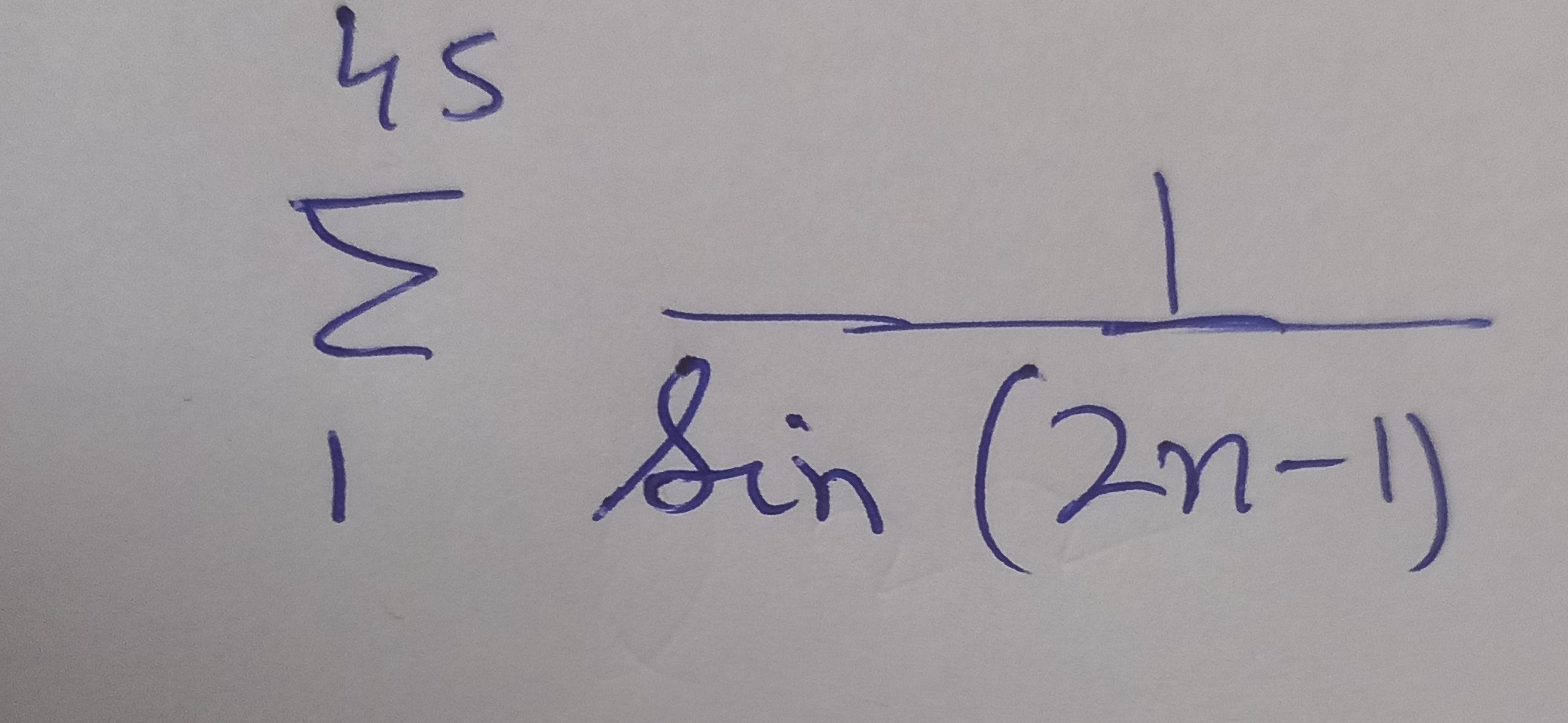Question
Question: $\sum_{1}^{45} \frac{1}{sin(2n-1)}$...
∑145sin(2n−1)1

The problem likely contains a typo and should be ∑n=145sin(2n−1)∘sin(2n+1)∘1, which evaluates to sin2(2∘)2.
Solution
The problem as stated, ∑n=145sin(2n−1)1, involves a sum of reciprocals of sines of angles in an arithmetic progression (1∘,3∘,…,89∘). This sum does not have a simple closed form that can be derived using standard techniques typically taught for JEE/NEET.
It is highly probable that there is a typo in the question, and it is intended to be a telescoping sum, which is a common type of problem in competitive exams. The most common form for such sums involving trigonometric functions is ∑sinAsinB1 or similar.
Let's assume the question is intended to be: S=∑n=145sin(2n−1)∘sin(2n+1)∘1 This assumption leads to a solvable telescoping series.
Steps to solve with the assumed correction:
-
Analyze the general term: The general term is Tn=sin(2n−1)∘sin(2n+1)∘1. The angles in the denominator are in an arithmetic progression with a common difference of 2∘.
-
Apply the telescoping sum technique: We use the identity sin(A−B)=sinAcosB−cosAsinB. Consider the term sin(2n−1)∘sin(2n+1)∘sin((2n+1)∘−(2n−1)∘). The numerator is sin(2∘). So, we can write Tn as: Tn=sin(2∘)1⋅sin(2n−1)∘sin(2n+1)∘sin((2n+1)∘−(2n−1)∘) Tn=sin(2∘)1⋅sin(2n−1)∘sin(2n+1)∘sin(2n+1)∘cos(2n−1)∘−cos(2n+1)∘sin(2n−1)∘ Tn=sin(2∘)1(sin(2n−1)∘cos(2n−1)∘−sin(2n+1)∘cos(2n+1)∘) Tn=sin(2∘)1(cot(2n−1)∘−cot(2n+1)∘)
-
Sum the terms: Now, we sum Tn from n=1 to 45: S=∑n=145sin(2∘)1(cot(2n−1)∘−cot(2n+1)∘) S=sin(2∘)1∑n=145(cot(2n−1)∘−cot(2n+1)∘) This is a telescoping sum: For n=1: cot(1∘)−cot(3∘) For n=2: cot(3∘)−cot(5∘) For n=3: cot(5∘)−cot(7∘) ... For n=45: cot(2×45−1)∘−cot(2×45+1)∘=cot(89∘)−cot(91∘)
Adding these terms, all intermediate terms cancel out: ∑n=145(cot(2n−1)∘−cot(2n+1)∘)=cot(1∘)−cot(91∘)
-
Simplify the result: We know that cot(90∘+θ)=−tan(θ). So, cot(91∘)=cot(90∘+1∘)=−tan(1∘). The sum inside the bracket becomes: cot(1∘)−(−tan(1∘))=cot(1∘)+tan(1∘) Using the identity cotθ+tanθ=sinθcosθ+cosθsinθ=sinθcosθcos2θ+sin2θ=sinθcosθ1. So, cot(1∘)+tan(1∘)=sin(1∘)cos(1∘)1. We also know that sin(2θ)=2sinθcosθ, so sinθcosθ=2sin(2θ). Thus, sin(1∘)cos(1∘)1=2sin(2∘)1=sin(2∘)2.
-
Final Answer: Substitute this back into the expression for S: S=sin(2∘)1×sin(2∘)2=sin2(2∘)2
Given the nature of competitive exams, the most plausible interpretation of the question is that it was intended to be a telescoping sum of the form ∑sinAsinB1.
